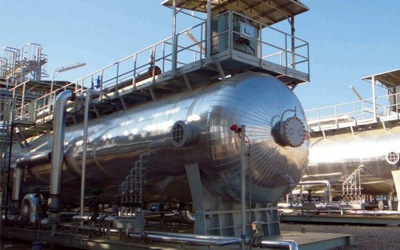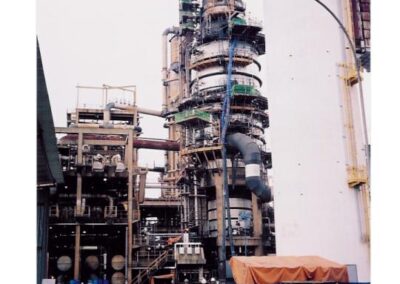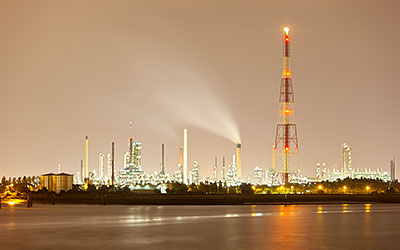Part 18
Paraffin Deposition Theory and Control
Paraffin deposition from crude oil or distilled intermediates produces two detrimental conditions – plugging and increasing energy demand – both of which are costly to the operator.
Paraffin deposition from crude oil or distilled intermediates produces two detrimental conditions – plugging and increasing energy demand – both of which are costly to the operator.
The temperature of the crude oil at which paraffin crystals (wax) first forms is called the cloud point. As the temperature progresses downward, the oil reaches a consistency where it will just pour, this is the pour point. As the operator goes through the cloud point, paraffin depositions form as they come out of solution in the oil and deposit in the walls of the confining space. The surface temperature of the equipment also is at the cloud point or below. In time, the confining transport of the oil demands maximum horsepower.
By spending extra energy, the oil can be heated and held to a condition above the cloud point. Considering the high cost of fuel to maintain the heated condition, it becomes more economical to utilize paraffin inhibitors (wax crystal modifiers) and solvent to eliminate deposition problems. Where pumping problems develop and where the temperature range is suitable, pour point depressants are useful.
When oil is produced from the subsurface through steel tubing or casing and moved from the wellhead to storage through steel piping lines, the accumulation of an organic deposit (commonly referred to as paraffin or wax) in the cooler sections of the piping can cause production problems that are both serious and costly. Paraffin control in domestic production is estimated to cost the petroleum industry multiple billions of dollars annually in lost production and maintenance expense to remove wax deposits in subsurface tubulars, and the cost to remediate above surface equipment. These costs do not include the expenses associated with maintenance encountered in the refining industry. These are direct costs which result from the periodic removal of accumulated crude paraffin by various mechanical, thermal and chemical means. Not included in this cost are increased horsepower requirements, damage or increased wear to equipment and manpower attention.
Crude paraffin deposits are composed of two main components; the paraffin or wax and the oil portion. These crude deposits usually have wax content ranging from 50-70% and the waxes are mainly crystalline hydrocarbons of high molecular weight (300-1000 units), with carbon chain lengths between C20 and C75. The melting point of the waxy crude deposits are usually between 120 and 200°F. Most of the heavy, waxy hydrocarbons in the deposits are saturated, straight carbon chain compounds, but occasionally small quantities of branched, isomeric or cyclic compounds will be present. The wax crystals may exist as plates, needles and in microcrystalline form. Plate-like crystals are thought to be made up of primarily saturated, straight chain hydrocarbons; needles are thought to be composed of branched chain molecules; and the microcrystals are thought to consist primarily of cyclic compounds.
At temperatures below the cloud point, the paraffin components begin to crystallize into solid wax particles. These can adhere to each other when the wax containing hydrocarbon comes in contact with any surface that has a temperature below the wax appearance temperature (WAT) and provides a heat sink. Although WAT and cloud point are often used interchangeably, the distinction is that the cloud point refers to the temperature at which the first wax crystals are observed in solution. The WAT is generally a slightly lower temperature that represents the point at which the bulk of the wax crystalizes. Pour point is another paraffin-related temperature and is the point at which the oil begins to solidify and will not flow without applying force.
Factors that affect paraffin deposition
Although the composition of the crude oil is a factor, we will leave it out here since in order to have a deposition problem, high molecular weight hydrocarbons must be present in the crude. When we have these high mole weight components in the crude, the four factors affecting the amount of deposition that will occur on a surface are:
1. Time
The rate of paraffin deposition from a wax solution decreases with time. Also, the wax content of the deposit increases with time, making the deposit harder. The reasons for these observations are;
- The depositing paraffin forms an insulating layer on the deposition surface and the presence of this layer reduces the temperature gradient (driving force) between the wax solution and the new deposition surface (outer surface of the paraffin at a higher temperature).
- The temperature gradient causes the wax and oil in the total deposit to separate, leaving more oil in the outer layers. This oil lowers the cohesive forces between the wax crystals on the outer surface thereby allowing the amount of paraffin to be reduced by shearing action on this outer surface of the deposit.
2. Temperature of Wax Solution
The temperature of the wax solution in contact with the deposition surface affects the amount of the wax deposited on this surface. The direction of the effect depends on the temperature being:
1. Above its cloud point. As long as the temperature of the deposition surface is below the cloud point temperature of the wax solution in contact with it, the amount of paraffin deposited on this surface decreases as the temperature of the wax solution is increased above its cloud point temperature. However, even at high solution temperatures the paraffin deposition cannot be completely eliminated if the temperature of the surface is below the cloud point temperature of the solution. The reason for this behavior is that as long as the deposition surface is below the cloud point temperature of the wax solution in contact with it, there is a volume of wax at or near the cold surface that is at a temperature below its cloud point. Also, the wax content of the deposit increases as the temperature of the wax solution increases.
2. The temperature of the deposition surface has pronounced effect on the deposition of paraffin from either refined or crude wax solutions in contact with it. The amount of paraffin deposited on the surface in contact with this wax solution increases as the temperature of the surface decreases below the cloud point. Larger temperature gradients increase the driving force of deposition. If the temperature of the surface is equal to or greater than the cloud point temperature of the wax solution, no paraffin will deposit on this surface. Also, the wax content of the deposit decreases with decreasing surface temperature. This fact is best explained by the initial deposit being thicker and lower in average molecular weight, and the separation of the wax and oil is less complete for a given length of time.
It has been determined that as the relative velocities (hence more shear) between the wax solution and the deposition surface, the smaller the amount of crude wax deposition (oil, wax, dirt, debris) on the surface. However, on a surface that has existing wax deposition, increased shear actually increases the wax content of the deposited material. This is due to the effect of nucleation attraction of existing wax molecules for additional wax accumulation while other, non-wax, debris is removed by shear force.
Mechanism of paraffin deposition
Based on the above factors, we can conclude the following mechanisms for paraffin deposition. The predominant mechanisms to describe paraffin deposition are:
1. Shear Dispersion
Shear dispersion describes the relationship between deposition rate and shear rate. Shearing of wax molecules occurs due to the hydrodynamic drag of flowing fluid and depends mostly on the flowrate and viscosity of the fluid. Higher viscosity and lower flow rates result in high wax deposition rates. However, in highly turbulent flow, deposition rates decrease with increased flow as wax is mechanically sheared off the deposits on the surface. As the deposit thickness increases, so does the shear rate due to decrease in the flow area and an increase in the flow velocity. This increase in shear rate causes an increase in the shear stress on wax molecules and formed wax crystals which serves to diminish the overall wax deposition rate.
2. Molecular Diffusion
Molecular diffusion describes the process by which radial temperature gradients in the line causes a concentration gradient of dissolved paraffin components in the liquid phase. The concentration gradient causes paraffin to diffuse to the metallic surface, where it is assumed to deposit. The recognized transport methods contributing to wax thickness on a metal surface are molecular diffusion of dissolved wax, particle transport of precipitated wax, and the sloughing of previously deposited wax.
The necessary temperature conditions for paraffin to deposit from a solution onto a surface in contact with it are: the temperature of the wax solution must be greater than the temperature of the deposition surface, which must be at a temperature below the cloud point of the wax solution.
Freshly precipitated wax crystals nucleate or absorb directly on the deposition surface. Then old wax crystals already out of solution can be driven to the fresh wax crystals on the surface and cohere. The deposition of the fresh crystals is a rapid process whereas the latter is much slower. This mechanism explains why no deposition occurs when the wax solution and the deposition surface are below the cloud point temperature of the wax solution, but the surface is warmer than the solution.
A concentration gradient is established as a direct result of the temperature gradient between the wax solution and the deposition surface. Adsorption forces at the metal surface cannot account for the concentration gradient except in the initial stage of deposition. Though adsorption is obviously important here, the adherent forces between wax and metal are not operative over more than a few molecular diameters.
Removal of paraffin deposition
Until recently, the most economical way to control paraffin deposition has been by removal after it has formed by the following methods:
Mechanical
1. Mechanical scrapers and cutters, attached to wirelines, are the most widely used tools in the petroleum industry for removing paraffin deposits from tubing of flowing and gas-lift wells. These tools are run periodically with the frequency of runs depending on the severity of the problem. Although nearly all wireline units are run manually, new automated wireline units have been installed in some locations. These units can be automatically cycled with a timing device.
2. Free Fall. Another type of scraper used in flowing wells is forced through the tubing by the produced fluid. There are two variations of this type of equipment; one goes up and down inside the tubing while the well is flowing and the other goes up with the fluid but drops only when the well is shut in. The first variation is rarely used since the weight of the scraper must be matched with the fluid production weight. The second type of tool is used more often in wells that are on stopcock or on intermittent gas-lift. Their purpose in gas-lift wells is to lift the oil out of the well more efficiently.
3. Rod Scrapers. Pumping wells are mechanically cleaned by scrapers attached to the pumping rods that travel through the paraffin deposit sections.
4. Flowline Plugs. Flowlines are often mechanically scraped by plugs which are forced through the lines by produced crude. There are two types of plugs: Soluble and Insoluble. The soluble plugs clean the flowlines and then dissolve in the stock tank crude oil. Most of these plugs are naphthalenes. The insoluble plugs are usually hard rubber or plastic. Automatic dispensers are available for periodically injecting sharp-edged spheres into the flowlines. These spheres are trapped at the end of the line for reuse.
All these mechanical tools mentioned above have been used in conventional completions on-shore and off-shore; but with the advent of underwater completions, new mechanical tools have been developed. The most recent tool is the pumpable paraffin scraper, which is pumped through the flowline and tubing by means of a cross-over system above.
Thermal
Heat to melt and dissolve the paraffin is used mostly to clean flowlines, but is sometimes used in the annular space to clean the tubing. Heat is usually supplied by hot oil, gas or water. Downhole electric heaters have been tried but have been too expensive for economical use. Also, heat has been supplied by chemical reactions, but the process is less than successful leaving objectionable deposits.
Solvents
The most expensive method for removing paraffin deposits is dissolving the wax deposit with solvents. Carbon disulfide is probably the best solvent for wax dissolution, however, it is toxic, flammable and has an offensive odor. Chlorinated hydrocarbon solvents are unacceptable to the refineries because they contaminate the refinery catalysts. These solvents are also largely dismissed due to being ozone-depleters. There are other solvents that have been tried but are ineffective in dissolving paraffin and hence require too large an amount to be economical.
Prevention of paraffin deposition
Prevention of the deposition of paraffin is the best method for controlling paraffin accumulation. There are three mechanisms to prevent paraffin deposition.
1. Keep Wax in Solution
Keeping wax molecules in solution can be accomplished by keeping the temperature of the surface and the wax solution above the cloud point temperature of the wax solution.
2. Keep Wax Crystals from Adhering to Deposition Surface
Adhesion can be lowered by making the surface smooth. There is a direct correlation between the severity of paraffin deposition and the roughness of the surface. The more irregular, damaged, scratched or abraded the surface the more attractive adhesional force is present due to the effect of nucleation. Plastic, glass, porcelain, rubber, ceramics and silicones have been used but have been found to not stop adhesion completely. These coatings lowered the adhesional forces between the wax crystals and the surface. The main disadvantage with these coatings are that they are easily scratched, permeable to oil after a period of time, being brittle and unbendable, and tend to degrade requiring more frequent replacement.
3. Keep Wax Crystals from Cohering to Each Other
Chemical products are now available that function to be wax inhibitors. These inhibitors can be divided into four types: pour point depressants, crystal modifiers, dispersants and solvents.
Pour point depressants hinder the formation of and growth of wax crystals by modifying the crystal structure by merging with the edge of a growing wax crystal. Although these pour point depressants reduce viscosity, yield stress and the pour point of the oil, it cannot reduce the rate of wax deposition. Pour point depressants function to reduce the temperature at which paraffinic oil begins to gel.
The wax crystal modifier has a similar molecular structure to wax. It coprecipitates or co-crystallizes with a wax crystal by replacing wax molecules on the crystal lattices. By doing so, it imposes a steric hinderance on paraffin crystals that interfere with the proper alignment of the new incoming paraffin molecules such that growth terminates. These chemicals act to disrupt wax crystal growth by adsorbing onto the wax crystals. By co-crystalizing with the native paraffin waxes in the crude oil, these interactions result in the deformation of the crystal morphology of the crude wax. Once deformed, these crystals cannot undergo the normal series of aggregation steps.
Types of paraffin crystal modifiers include:
- Maleic acid esters
- Polymeric acrylate and methacrylate esters
- Ethylene vinyl actetate polymers and copolymers
- Olefin Ester Copolymers
- Ester/Vinyl Acetate Copolymers
- Alkyl Phenol Resins
Dispersants are similar to surfactants in their molecular structure. Paraffin dispersants act to keep wax nuclei from agglomerating by breaking wax crystals into smaller particles and reduce the rate of deposition and prevent it by minimizing wax adhesion to the metal surface. Dispersants are generally surfactants and may also keep metal surfaces water wet, minimizing the tendency of the wax to adhere.
Solvents increase the solubility of wax in oil and so dissolve already deposited wax. The solvents most commonly used include aromatic compounds such as toluene, xylene, white or unleaded gasoline and terpenes.
Wax accumulations in flow lines, operating equipment and subsurface oil-bearing formations pose formidable problems to the production and processing of crude petroleum.



